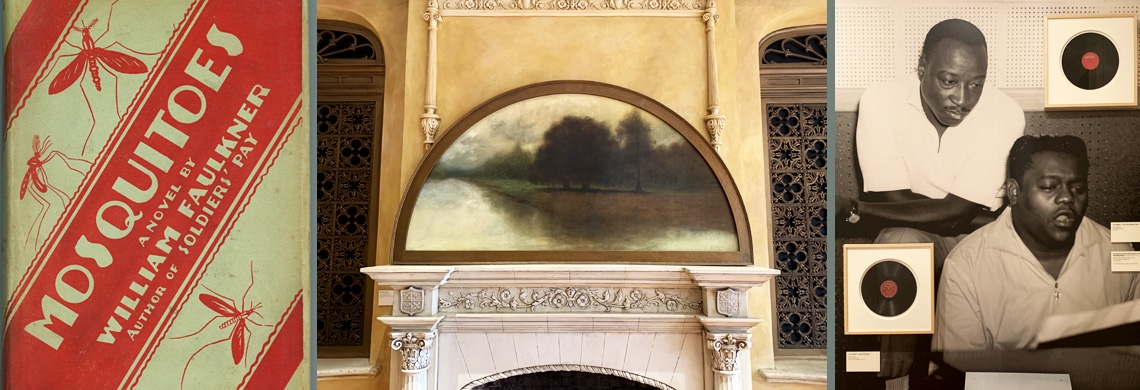The galleries at 520 Royal Street are a showcase for new and old—from cornerstones of THNOC’s collection to items acquired more recently to populate current exhibitions. Here are six treasures to be found at the newly expanded Historic New Orleans Collection.
1) Streetcar operator's cap
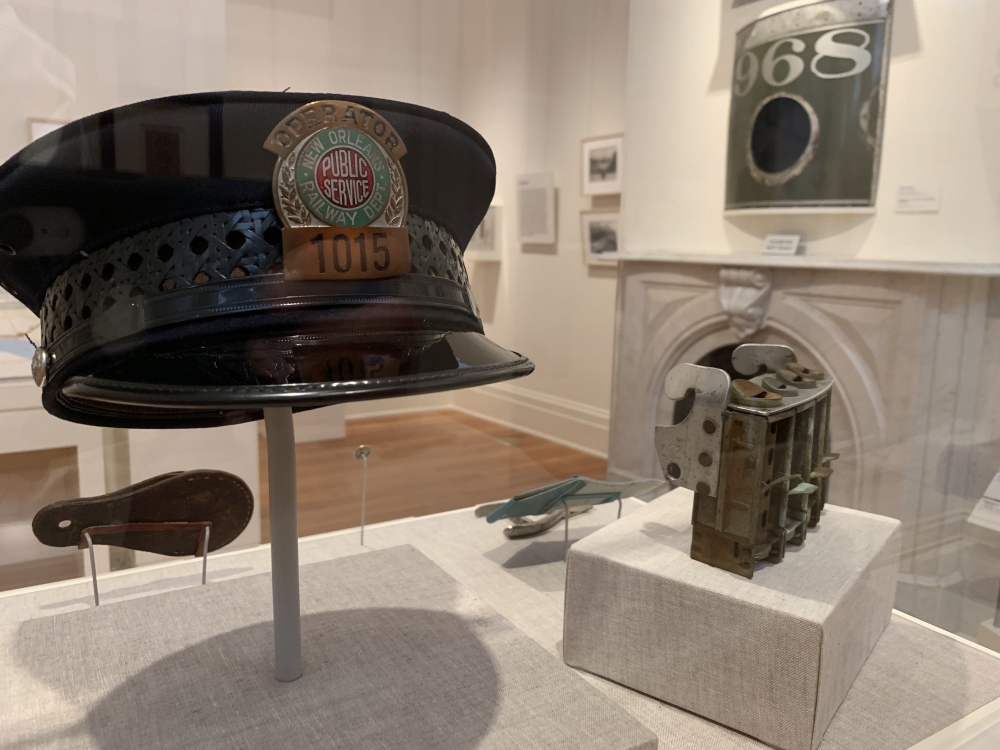
Items from the Marie Finhold Streetcar Collection on display in the French Quarter Galleries. (THNOC, gift of Stephen J. Stegemeyer, 2010.0255)
Light rail in the Crescent City dates to 1830, when the Pontchartrain Railroad Company received a charter for the first passenger rail system to shuttle people from the foot of Elysian Fields Avenue to the lakefront faubourg of Milneburg. The first cars were horse drawn, but by 1832 the steam-powered “Smokey Mary” was also in operation, earning its nickname from the soot it belched all over passengers’ (and onlookers’) clothing. This rail line created an economic boom for the small Milneburg community, which became a resort destination for residents and tourists alike.
The rail system that became the St. Charles Avenue streetcar line began running in 1835, again by horse-drawn carriage, and originally connected New Orleans to the resort district of Carrollton. Commuter streetcars took some time in gaining popularity; by the outbreak of the Civil War there were only four lines operating. By 1926, however, the city of New Orleans had 26 streetcar lines running on 221 miles of track. This was the peak year for public transportation in New Orleans, with electrified passenger cars transporting 148 million passengers annually.
In March 2008 the Marie Finhold Streetcar Collection was donated to THNOC by her nephew, Stephen J. Stegemeyer. Finhold was employed as a streetcar operator at the age of 19 during World War II. After the war ended, she joined the Franciscan Order and became a missionary, providing aid to communities in Latin America. Upon her return to the United States, she resumed her station as a streetcar operator, eventually becoming known as the “Flying Nun” of the St. Charles line. Finhold was an avid collector of all things related to streetcars and kept ticket punches, change machines, operator badges, caps, watches, route maps, and many other items that wonderfully preserve the history of public transit in New Orleans. The operator’s cap currently on display dates to the mid-1940s and anchors an array of items from Finhold’s incomparable collection.
—Matt Farah, associate curator of traveling exhibitions
2) Black River Country by Alexander John Drysdale
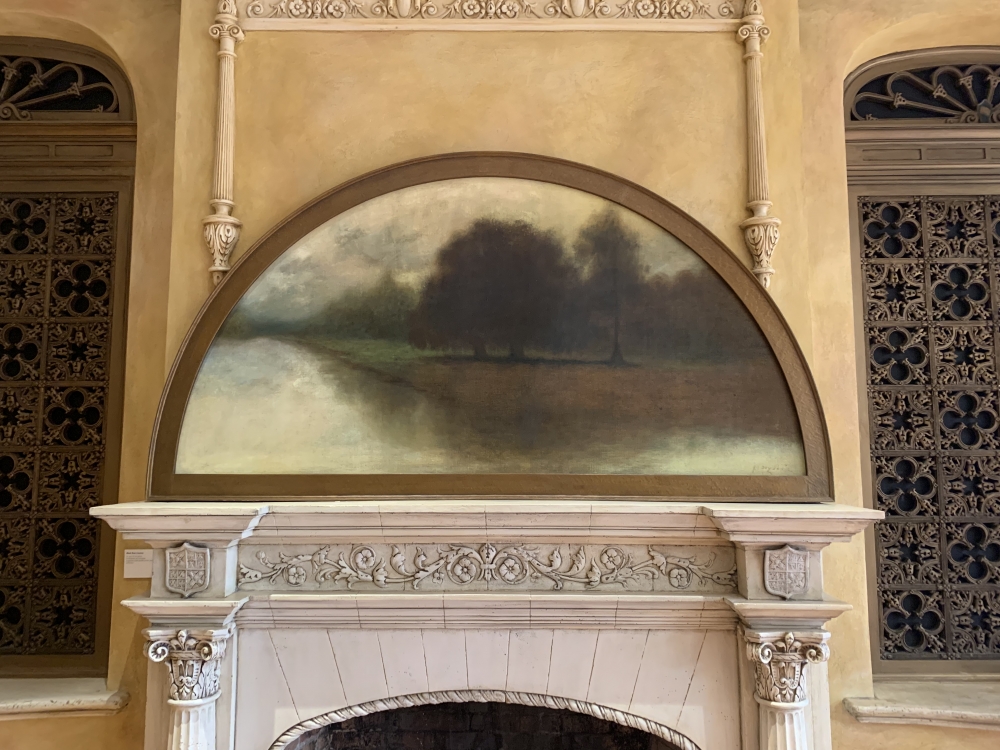 The circa 1927 oil painting hangs above a fireplace in the organ room at the Seignouret-Brulatour Building. (THNOC, acquisition made possible by the Laussat Society, 2018.0513.2)
The circa 1927 oil painting hangs above a fireplace in the organ room at the Seignouret-Brulatour Building. (THNOC, acquisition made possible by the Laussat Society, 2018.0513.2)
Alexander John Drysdale (1870–1934) is known for his misty, tonalist Louisiana scenes. Inspired by the state’s wetlands, Drysdale “drifted along the bayous in a boat,” according to biographer Howard A. Buechner, “a mustached figure in old clothes, puffing his pipe, and finding inspiration in Barataria, Teche, Chef Menteur, and Black River.” This demilune (half moon) painting, Black River Country, is typical of his canvases. Between 1910 and 1916 Drysdale developed the technique for which he is remembered today: thinning his oil paints with kerosene or coal oil in what he termed “a watercolor technique applied to oil.” Drysdale lined up his canvases and first painted in the sky, after which he delineated land areas with quickly rendered brushstrokes to represent swamp grasses and marsh flowers. His impressionistic landscapes frequently feature a single moss-draped oak tree, but Black River Country depicts a pair of oaks flanked by a cypress.
THNOC acquired Black River Country to install in a place of prominence in the Seignouret-Brulatour Building, because Drysdale has a strong connection to the painting’s new home. He was a member of the Arts and Crafts Club of New Orleans, which incorporated in 1922. Banker and philanthropist William Ratcliffe Irby, who owned the building at the time, renovated it for the club’s use as part of his commitment “to great charitable efforts and to the use of his large fortune for the benefit of his fellow citizens,” according to an obituary of the benefactor. He also purchased a number of Vieux Carré properties to save them from demolition. At the time of his death, in 1926, Irby was remodeling the upper part of the building with the intention of moving there. Among the fittings Irby installed was a $20,000 pipe organ.
Historical photographs show a landscape hanging in Irby’s organ room. Accordingly, THNOC looked to landscapes when selecting an artwork for the newly restored space, and Drysdale was chosen for his prominence among Louisiana landscape artists of Irby’s period. Black River Country belongs to a 22-painting series commissioned in 1927 for and subsequently exhibited at the D. H. Holmes Department Store on Canal Street. The installation of Drysdale’s vintage landscape in this room, made possible by the Laussat Society, is an ideal representation of Irby’s contribution to the reclamation of the historic structures of the French Quarter, particularly the Seignouret-Brulatour Building.
—Judith H. Bonner, senior curator
3) Mosquitoes by William Faulkner
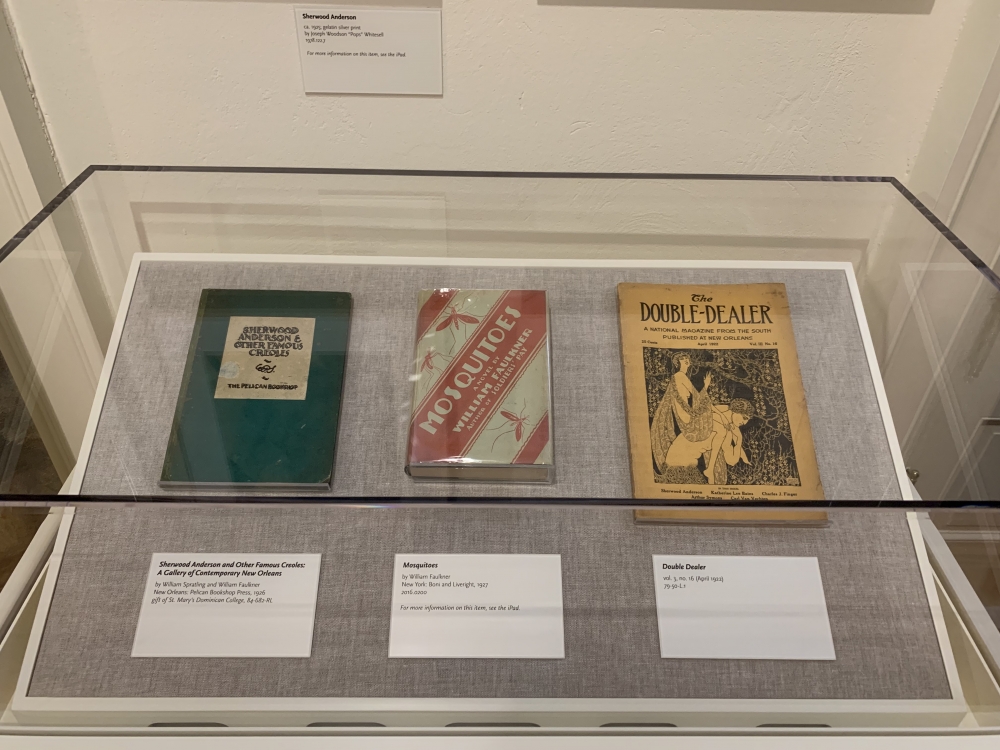
A first edition of Mosquitoes is mounted between a copy of Sherwood Anderson and Other Famous Creoles and an edition of the Double Dealer in the French Quarter Galleries. (THNOC, 2016.0200)
Mosquitoes (1927), William Faulkner’s second published novel, following Soldiers’ Pay (1926), reflects his experiences in New Orleans’s bohemian art and literary scene of the 1920s. Faulkner had grown up in Oxford, Mississippi; served briefly in World War I; enrolled—but never finished—at the University of Mississippi after the war; and worked for a short while in New York, where he met Elizabeth Prall, who became the third wife of acclaimed writer Sherwood Anderson. The Andersons moved to the French Quarter, and Faulkner, 27, an aspiring poet, looked them up when he arrived in New Orleans early in 1925. He and Sherwood Anderson immediately developed a rapport, with the established author of the classic American short story cycle Winesburg, Ohio (1919) sharing literary advice and steering Faulkner from poetry to fiction. Anderson furthered Faulkner’s literary ambitions by recommending the manuscript of Soldiers’ Pay to his own publisher in New York, Horace Liveright, of Boni and Liveright.
In March 1925 Faulkner participated in a nautical jaunt, organized by Anderson, across Lake Pontchartrain to Mandeville. The party was plagued by engine trouble, stormy weather, and mosquitoes, and it became the basis for Faulkner’s next novel. He used fictitious names to describe his fellow travelers, but many locals recognized themselves or others in Mosquitoes—sometimes to their chagrin.
Faulkner returned to Mississippi following the release of Sherwood Anderson and Other Famous Creoles and before Mosquitoes was published. He had lived in New Orleans for less than 16 months and would never call it home again. This first edition of Mosquitoes features its original red and cream book jacket, laid out in a bold art deco design.
—Pamela D. Arceneaux, senior librarian/rare books curator
4) J. & J. W. Meeks dresser
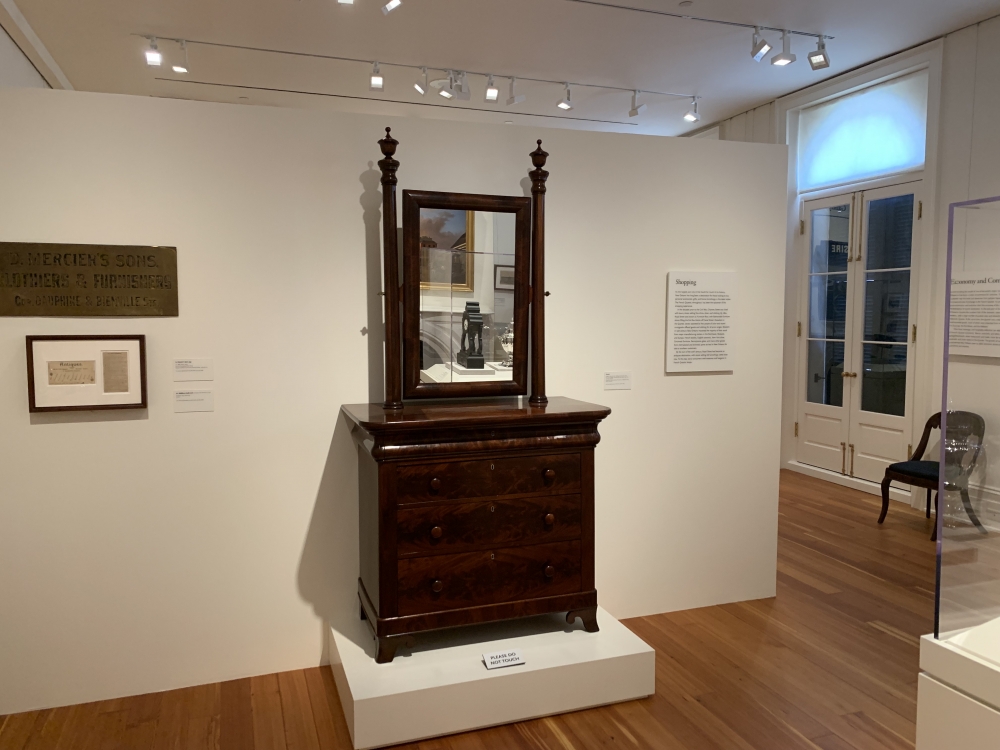
This dresser, made between 1836 and 1839, is on display in the French Quarter Galleries. (THNOC, acquisition made possible by the Clarisse Claiborne Grima Fund, 2016.0292)
This stately dresser is the second piece of furniture acquired by THNOC in the past five years bearing a paper label from the Chartres Street warerooms of J. & J. W. Meeks, prominent New York furniture manufacturers. Known for producing fine furniture in neoclassical styles, the Meeks family, headed by Joseph Meeks Sr., was selling furniture directly to the New Orleans market by 1822. Joseph’s sons, John and Joseph W., took over the business after their father’s death in 1836. Another son, Theodore Meeks, was dispatched to New Orleans to run the retail outlet on Chartres Street. Although that store closed in 1839, Theodore remained in New Orleans, serving as an agent for his family company in addition to operating the Verandah Hotel. Later in life, he was unanimously elected mayor of the suburb of Carrollton.
Meeks furniture was elegant, stylish, and expensive. It could be found in upper-class homes across the country and was especially popular in the Greek Revival plantation houses of the Gulf South. The Meeks outlet on Chartres Street brought this fine furniture directly to wealthy southern customers. In addition, the shop outfitted steamboats and other prominent public spaces—such as the first St. Charles Hotel, upon its opening in 1837—with fashionable furnishings. This dresser, with three large drawers, a narrower drawer hidden in the undulating molding at the top, and a mirror supported between two pillars, would have been a sought-after addition to a bedroom or dressing room in an urban or rural home.
The paper label in the top drawer of this dresser is in good condition and is very rare. The firm’s name, New York address, and Chartres Street location indicate that the label and the dresser date between 1836 and 1839. Finding original labels on antique furniture is exciting and uncommon; only half a dozen of these labels from the Meeks store on Chartres Street are known to exist. Of the six, The Historic New Orleans Collection now owns two, one attached to this dresser and the other associated with a green velvet–covered sofa (2014.0381) on display in the Louisiana History Galleries.
—Lydia Blackmore, decorative arts curator
5) “The Fat Man” / “Detroit City Blues” by Fats Domino
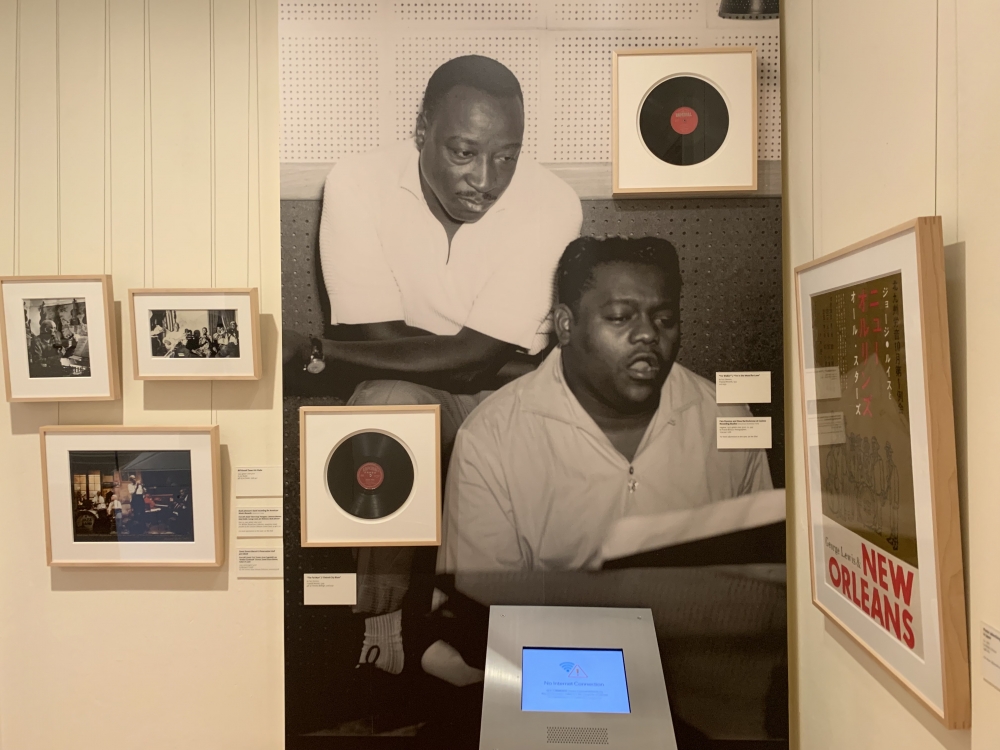
Two of Fats Domino’s recordings are mounted in a photographic display of him and Dave Bartholomew in the French Quarter Galleries (THNOC, gift of Timothy Bollinger, 2018.0140)
In the late 1940s, as New Orleans rhythm and blues was beginning to coalesce, Antoine “Fats” Domino Jr. was himself starting out as a performer, playing a regular gig at the Hideaway Club in the Ninth Ward. During these years, Domino’s cousin, banjo player Harrison Verret, was instrumental in nurturing the young musician’s natural talent. Verret was a successful musician in his own right, playing with Oscar “Papa” Celestin’s band as well as performing periodically with barrelhouse pianist Kid Stormy Weather. Among the songs in Kid Stormy’s repertoire was “Junker Blues,” which fellow New Orleanian piano player Champion Jack Dupree had recorded for the OKeh label in 1941. Domino took to the song as well and incorporated it into his act at the Hideaway.
In 1949 Dave Bartholomew, the venerable bandleader and A&R man for Imperial Records, visited the Hideaway with label owner Lew Chudd to scout the young Domino. Not surprisingly, they liked what they heard, quickly signed him to a contract, and got him into Cosimo Matassa’s J&M Studios on Rampart Street at the edge of the French Quarter. That session produced Domino’s first hit, “The Fat Man,” which reached number two on the Billboard R&B chart and number one on the local charts. The record continued to sell over the next few years, topping the one million mark in 1953, and is considered to be one of the first rock and roll songs. A cleaned-up version of “Junker Blues,” Domino’s hit stripped that song of its drug references and added a rollicking beat and a full-band sound designed to appeal to a wider audience. Bartholomew rounded out the session with musicians from his own band, one of the best in the city at the time, including Earl Palmer on drums and Red Tyler on saxophone. Over the next decade, Domino, Bartholomew and his band, and Matassa recorded a string of national hits that would come to define the local rhythm and blues sound and influence the development of rock and roll around the world.
—Eric Seiferth, curator/historian
6) 7:28AM August 30, 2005 by Neil Alexander
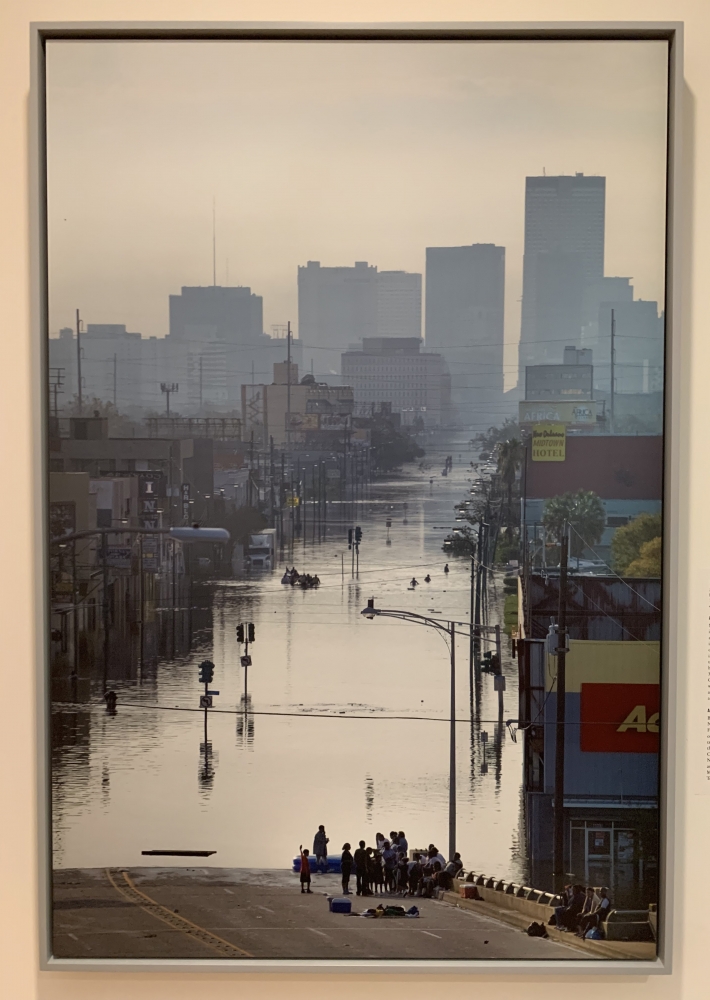
Alexander’s work is mounted in the exhibition Art of the City: Postmodern to Post-Katrina, presented by The Helis Foundation (THNOC, gift of the artist, 2017.0253)
The morning after Hurricane Katrina struck New Orleans, Neil Alexander left his Tchoupitoulas Street home with a friend who had ridden out the storm with Alexander and his family, to attempt to check on the friend’s house in Lakeview. Alexander’s house, situated on the high ground near the river, had escaped major damage, but most of the rest of the city, he soon realized, had fared far worse.
They drove Alexander’s Subaru Outback onto Interstate 10, and as they passed above Tulane Avenue, they encountered the scene depicted in 7:28AM August 30, 2005., which is featured in THNOC’s new exhibition Art of the City: Postmodern to Post-Katrina, presented by The Helis Foundation. “At that axis, at the conclusion of Highway 61, you can see right into the city,” Alexander said. “The whole tableau caught my eye. I was still processing it, but as a photographer, capturing that moment was kind of instinctive.”
Alexander has lived in New Orleans for more than four decades, working as an architectural photographer and documentary filmmaker. Since first arriving on a cross-country road trip and deciding to leave his native Pennsylvania behind, Alexander has spent most of his life capturing the culture of New Orleans. Aware that he was fortunate to have been able to shelter in place safely during the storm, Alexander grabbed his Canon digital camera and a 200 mm lens as he left his house that morning, because he “thought that was my mission as a filmmaker and photographer, to document the city.” Alexander is one of dozens of contemporary artists whose work makes up Art of the City, which debuted with the April opening of The Collection’s new exhibition center. “I’m honored to be in the company of so many amazing artists,” Alexander said. “We’re all responding to the emotional quality of the city, no matter what our medium is, no matter what our technique is. Mine happens to be a camera and lens.”
—Nick Weldon, associate editor
See these objects and many more on view at The Historic New Orleans Collection's new exhibition center at 520 Royal Street, open Tuesday–Sunday from 9:30 a.m. through 4:30 p.m. Admission is free.
A version of this article appears in the Spring-Summer issue of The Historic New Orleans Collection Quarterly.

